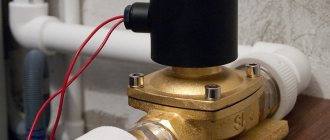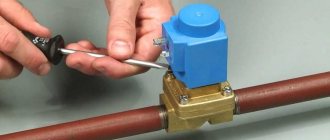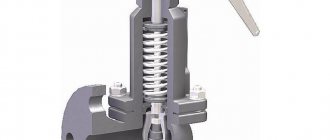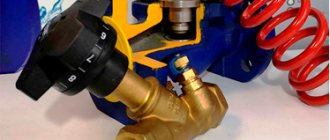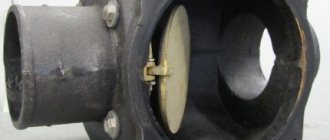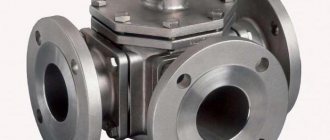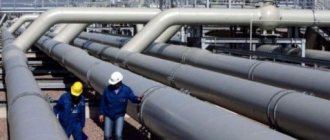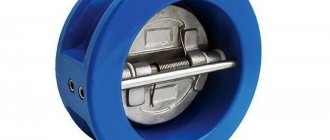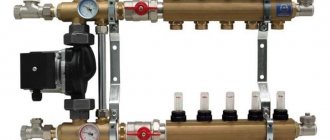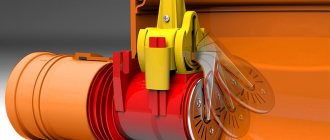03/25/2016 No comments Category: Automation in everyday life, Basics of automation
An electromagnetic valve is an actuator used in automation to open/close gas or liquid flows. These devices are an integral part of heat and water supply systems, automatic irrigation, liquid level control systems in the tank, etc.
Principle of operation
The solenoid valve consists of a coil with a core and a closing mechanism (valve and diaphragm). When voltage is applied to the coil, a magnetic field appears in it, which causes the core, together with the locking mechanism, to change its state in relation to the original position.
Rice. 1 Normally closed (NC) valve
When the supply voltage is removed, the valve returns to its original state due to the mechanical action of the spring.
Reasons for failure of solenoids in automatic transmissions, diagnostic difficulties
Despite their durability and reliability, automatic transmission solenoids sometimes fail, become deformed, and break.
The most common causes of solenoid failures:
- Accumulation of harmful oil deposits on metal rods.
- Lack of response to electrical signals (the rod gets stuck and does not extend).
- Core jamming.
The use of cheap, low-quality transmission oil or failure to meet the deadlines for a complete service replacement of the lubricant leads to the final destruction of the functionality of the solenoids in automatic transmissions. Wear products included in the working fluids are gradually deposited on the surface of the magnetized rod.
Such a breakdown is difficult to detect during diagnosis. To avoid failures in transmission control, it is recommended to fill the crankcase with transmission oil of the appropriate quality, and also not to ignore the car manufacturers’ recommendations on regular replacement of lubricant.
Service companies carry out computer diagnostics of automatic transmissions, including solenoids. If necessary, unsuitable solenoid valves are replaced here with new mechanisms. Masters of specialized points can instruct in detail how to check the performance of solenoids.
Normally open and normally closed solenoid valve
In the normal state (when there is no control voltage on the coil), the valve can be open (normally open valve) or closed (normally closed valve).
In what cases are NC valves used, and in what cases are NO valves used? It all depends on what state is considered the safest - the state to which the valve should return in the event of an emergency loss of control voltage. For example, in a leakage protection system, an EM valve is installed in an apartment on the inlet pipeline to shut off the water supply in the event of a leak. If you install a NO valve in such a system, then in the event of a power failure in the apartment, the valve will remain open and will not protect against leakage. Therefore, in this case, the safe state is “normally closed”.
If, from a safety point of view, both states of the valve are equivalent, then take a valve with such a normal state in which the device will remain in operation longer in order to reduce energy costs.
Do I need an extension for the door frame?
In any room, doors and frames differ in parameters and characteristics. For example, in the bathroom their dimensions are narrower than those of the interior rooms, while the entrance doors are more spacious. That's why there are standards and size ranges.
When measuring the width of the box, it is necessary to determine the indicators of the opening and panel, since all characteristics are interrelated.
Rice. 3. Scheme and composition of the strip
Regardless of the convenience and aesthetics of the extensions, they do not always need to be installed. Their installation is carried out only in a situation where the width of the box is less than the wall opening for framing.
Characteristics and selection of an EM valve
The main characteristics that you need to pay attention to when choosing a valve:
- Valve type : normally open or normally closed. Which type of valve to choose is discussed in detail in the previous section.
- Connecting dimensions : diameter and thread type.
- Overall dimensions : the valve must fit where it is planned to be installed.
- Maximum Pressure (PN) : The maximum fluid pressure at which the valve can operate. You need to choose it with some margin relative to the operating water pressure in your system.
- Working pressure range (ΔP) . The upper limit is usually the same as PN. The lower limit is also important: if the pressure in the system does not reach the lower limit, the valve may simply not open.
- Weight . If the valve weighs a lot, you will have to think about additional fasteners for it so that it does not bend the pipeline on which it is installed.
- Control voltage type : AC or DC, coil operating voltage. Must be taken into account when designing a valve control system.
Disadvantages of the heating system
When choosing an option for heating rooms, it is important to know how to properly install heating with a single-pipe system; you should also take into account its disadvantages:
- The system takes a very long time to start up after a long period of inactivity.
- In two-story houses, the radiators on the upper floor receive hotter water than the radiators on the lower floors. At the same time, achieving balance is quite difficult. The problem can be solved by installing additional radiators, but this is expensive.
- While repairing a single-pipe heating system of a private house with your own hands, a complete shutdown is required.
- The absence of a slope in the system leads to the formation of air pockets and a corresponding decrease in heat transfer.
- The operation process is accompanied by significant heat loss.
Solenoid valve control
An important characteristic of an EM valve is the type of control voltage. In automation systems this is most often 220 V AC or 24 V DC. The valve is controlled using a discrete key. This can be an automation relay circuit, a manual button or a controller relay output.
The figure shows the control of a valve with a 220 V coil. The control circuit for a coil designed for direct current 5, 12, 24 V is identical. However, in the case of direct current, it is important to maintain the polarity of the control voltage.
see also
Comments 23
the part of the circuit near the beep is not very good
Gentlemen, tell me what is the reason for the valves being installed directly on the tank, but as soon as you lower the receiver, the air leaves the airbags! And the steering wheel also pulls, could it be because of the valves?
valves have a direction - on one side the pressure should be greater than on the other - i.e. there must be more pressure in the res than in the airbags, otherwise there will be a descent like yours
Pipe valve near the bridge? Put it under the hood so it doesn't freeze
The valve will be on the pipe itself... And the pipe will be on the bottom in the niche under the rear seats next to the receiver...
The main thing is not to forget to warn passengers so that the bricks do not crumble later))))
Connect 1 and 2 and there will be happiness!
One more thing... According to science, the compressor pneumatic switch is screwed into the receiver. It's true. But if there is an ordinary Chinese one, as in the picture, then to save it you can transfer it through the tray to a tube with a pressure gauge and place it in the cabin, and not on the bottom.
I understand... I’ll take it into account... but probably as a further modernization... because it’s too far to chase after fittings... I’ll redo it if necessary...
A HUGE THANK YOU to everyone who responded!
1. It is impossible to damage the coil by incorrect connection. You can ruin the wires... or the battery. Incorrect connection is usually noticeable either by a non-functioning valve or by bright sparks and burning wires. The correct one is the click of the valve. If your hands are not positioned, just carefully poke the wires into the contacts. You will find the ones you need.
2. Polarity does not matter for the coil. Translation: you can swap + and -, the coil will still work.
Do I need to install a relay? ... or you can just do it directly... is a fuse required and how many Amperes?
"""Do I need to install a relay? ...or you can just go straight...""""depending on what buttons they control. If you hold more than 1 ampere, you can directly.
""""is a fuse required and how many amperes?""""" for what? what is the diagram, what are the valves on the fuse, how many are there?
Added introductory notes to the post...
Threat... a local electrician said... that it’s better to put a fuse... on each valve... they say they won’t be superfluous...
In beauty, it’s done like this: You take + After it, you immediately install a 5-10A fuse. You distribute this plus to all your valves.
You take the minus wherever you like and use the buttons to apply it to your valves.
ps. Relay switching signal type? Jerk off is a strange decision. A more powerful toggle switch will be enough. Or a 5-pin INSTEAD of the original signal relay. But not an additional relay if there was none.
PS2. No need to protect every valve
PS3. There are enough buttons for these valves, no relays are needed
Thanks again, I'll take everything into account...
""ps. Relay switching signal type? Jerk off is a strange decision. A more powerful toggle switch will be enough. Or a 5-pin INSTEAD of the original signal relay. But not an additional relay if there was none""
Now there is clarity on the signals... in place of the regular one... I installed Volga signals through the relay... because the regular ones died... now the Volga signals are standing... so as not to pay for the heart attacks of a pedestrian who accidentally drove onto the road... from Typhon... the Volga signals must be left... from the power supply of the Volga signal after the relay through the button , the same one shown in the picture above, we take off the power to the valve... and drive away the trucks occupying the left lane, as necessary... I’m unlikely to be able to organize bells and whistles with the relay...
If the relay is ALREADY installed, then the diagram is absolutely correct. Naturally, there should be a five-pin relay.
I meant that if there was no relay at all or there was a native one in the block, then an additional one is not needed, but it’s easier to get by with a toggle switch.
Plus and minus don't matter. And connect terminals 1 and 2. Take wires with a cross-section of 0.5...0.75.
Will sections of 1-1.5 spoil the porridge?
What the guy said was right about the minimum cross-section. More - ad infinitum.
When using water supply and heating systems, no one is immune from emergencies. An electromagnetic (solenoid) water valve allows you to minimize risks and losses in the event of a breakthrough. This device allows you to quickly shut off or, conversely, open the flow of water in a few seconds, while at a distance. Let us examine in detail how the solenoid valve is designed, its types, principles of operation and installation.
Application of Solenoid Valve
In one of our articles we talked about organizing an irrigation system at a summer cottage. When creating a watering machine, we actively used various types of solenoid valves.
We invite you to read this article.
Tags: relay, Solenoid valve
What are the consequences?
Many car owners are often concerned with the question of whether it is possible to ignore an exhausted solenoid valve and what the consequences of this are, if there is any alternative or if they need to urgently go to a service station.
Let's go in order. Essentially, the electrovalves open the channel of the blocked clutch of the clutches. Of course, the speed can be switched with jerks, it’s not scary, especially since you know that this is a faulty valve. But at the same time, we must also not forget that the channel itself may not be fully open or closed, which is akin to a clutch not being fully released in a manual transmission.
This will create a lack of pressure and operation in dry mode, which will cause combustion of both oil and clutches, and the production of all iron and bushings will begin. Ultimately, you will get the death of the solenoids due to their operation at full cross-section.
Read with this
